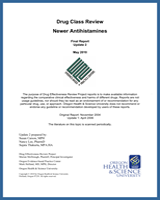| Allegra 1993 | Yes, computer-generated list | Method not reported | Yes | Yes | NR; study reported as 'double blind” | NR; study reported as 'double blind” | Yes | Attrition reported (none). Crossovers, adherence and contamination NR. | No (no attrition) | Yes, assuming no cross-overs | None | NR: Affiliation of last author is UCB Pharma
Secotor R & D, B-1420
Braine-l'Alleud, Belgium | Fair |
Bender 2003
US | Method not reported | Method not reported | NR | Yes | NR; “double blind” | NR; “double blind” | Yes (double-dummy, placebo) | NR | NR | NR | NR | GlaxoSmithKline | Poor: can't determine if groups were similar at baseline and number analyzed not specified |
Boner 1989
Italy | Method not reported | Method not reported | Yes; loratadine patients exposed to higher pollen counts, but difference NS (p=0.09) | Yes | Yes | Yes | Parent not masked; unclear if child aware | Attrition reported (4/40); adherence measured but results NR | 10% attrition | No, 36/40 analyzed; no reporting of cross-overs | No | NR | Fair |
Ciprandi 1997a
Ciprandi 1997b
Italy | Method not reported | Method not reported | Yes (no statistics) | Yes | Yes; described as 'double blind' but unclear who was blinded | Yes; described as 'double blind' but unclear who was blinded | Yes; described as 'double blind' but unclear who was blinded | Attrition yes, others no | No | Yes | No | NR | Fair |
| Jordana 1996 | Method not reported | Method not reported | Yes | Yes | NR; study reported as 'double blind” | NR; study reported as 'double blind” | Yes | Attrition reported (12/240);
others NR | No; ITT results presented, 240 of 242 analyzed | No, 2 patients withdrew prior to randomization; remainder of patients analyzed | None from ITT group, whose results were presented | Glaxo Canada Inc. | Fair |
| Masi 1993 | “Block randomization was done according to the order of inclusion into the study” | NR | Yes | Yes | NR; study reported as 'double blind” | NR: study reported as “double blind” | Yes | Yes; no, yes, no. Of 10 patients not analyzed at follow-up, 4 were due to AE, 2 due to lack of efficacy, 1 protocol violation, 2 lost to follow-up | No (10/124) | All patients were reported to be included in both efficacy and safety analysis | 1 due to protocol violation, 2 due to lack of efficacy | NR: third author affiliation is UCB
Pharma Secotr R & D, B-1420 Braine-l'Alleud, Belgium | Fair |
Pearlman 1997, Winder 1996 (safety)
US | Method not reported | Method not reported | Yes | Yes | Study described as 'double blind' but unclear who was blinded | Study described as 'double blind' but unclear who was blinded | Study described as 'double blind' but unclear who was blinded | Attrition reported, adherence and contamination no | No | No (205/209 analyzed) | 2 patients removed for poor compliance and 1 for protocol violation | U.S. Pharmaceuticals
Group, Pfizer, Inc. | Fair |
| Segal 2003 | Method not reported | Method not reported | Baseline characteristics reported only for analyzed group only (164/172 analyzed) | Yes | NR; study reported as 'double blind” | NR; study reported as 'double blind” | Yes | 16 patients discontinued treatment during study, usually due to unrelated intercurrent illness. | Attrition 16 (9.3%) and 8 post-randomization exclusions. Only patients <25kg were analyzed (n=146), as too few patients in the <25kg group. | No, attrition and post-randomization exclusions | 8 patients excluded from efficacy analysis:
7 due to protocol violations, 1 withdrew before onset of study. | Pfizer Inc., New York, New York | Poor: post- randomization exclusions, exclusion of nasal congestions from TSS, baseline characteristics NR for entire group |
| Tinkelman 1996 | Method not reported | Yes (drug dispensed by nurse independent of investigator) | Yes | Yes | NR | NR | No | Attrition reported (6/188); adherence NR | No | No, 182/186 analyzed; no mention cross-overs | No | U.S. Pharmaceuticals
Group, Pfizer Inc,,
New York, NY | Fair |
Wahn 2003;
Meltzer 2004
15 countries | Method not reported | Not reported | More males in placebo group; otherwise similar. | Yes | Yes; described as 'double blind' but unclear who | Yes | Yes | Attrition and adherence yes, contamination no. | No | No (932/935 analyzed); only analyzed if compliant with medications and data available | Excluded if noncompliant with medications after randomization | Aventis
Pharmaceuticals | Fair |
